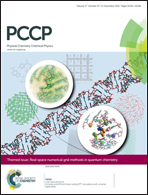Synthesis of branched Pd nanocrystals with tunable structures, their growth mechanism, and enhanced electrocatalytic properties†
Abstract
Branched Pd nanocrystals (NCs) with tunable architectures are synthesized in high yields (>95%) by simply adjusting the concentration of H2PdCl4 in the presence of fixed amounts of cetyltrimethylammonium bromide (CTAB), L-ascorbic acid (L-AA), and CuBr2− that is produced by reducing CuBr2 with L-AA. The as-synthesized branched Pd NCs have long, straight branches with thin diameters. At the same time, the growth process of the branched Pd NCs is monitored, which provides mechanistic insights for the branching growth of Pd NCs. It is identified that a high concentration of CTAB combined with an appropriate amount of CuBr2− species, acting as an in situ cooperatively organized template, is a decisive factor for the anisotropic growth of the branched Pd nanostructures during aqueous-phase reduction of the Pd precursor, using L-AA as a reducing agent. The electrocatalytic activities of the branched Pd NCs were tested. The branched Pd NCs are found to be an excellent electrocatalyst for the methanol oxidation reaction (MOR) largely due to the size and morphological effects of the branched structures.


 Please wait while we load your content...
Please wait while we load your content...